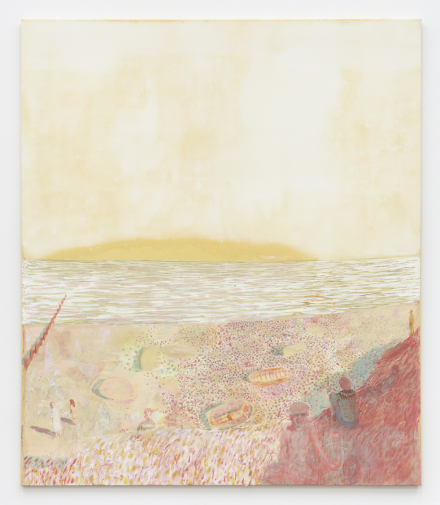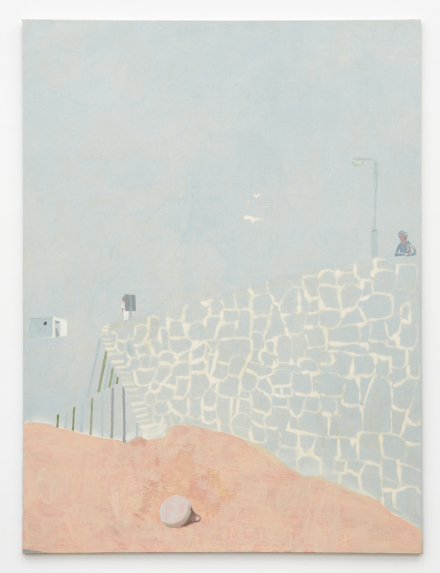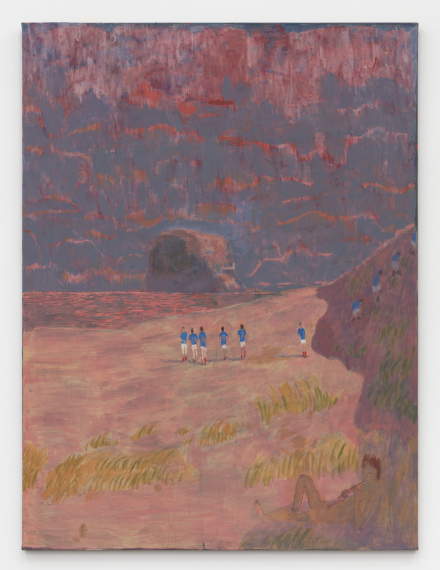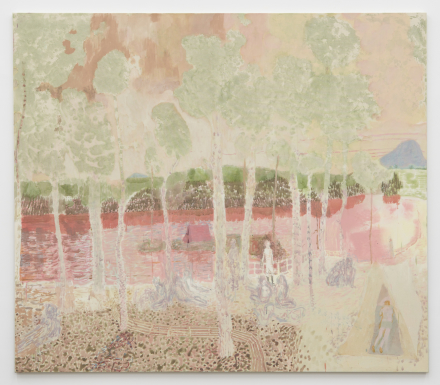
Andrew Cranston, It was your birthday (and a seagull shat on your head) (2021), via Karma
This month, Karma presents a body of recent works by the British painter Andrew Cranston, marking his first solo exhibition in New York. The artist, who creates transportive images that destabilize the viewer’s sense of time, and invite them to explore a space between nostalgia and dream, relies on dense marks of oil and subtle washes of distemper, using the material to guide the viewer through a series of relationships in space and depth.

Andrew Cranston, Cornwall, 1979 (2021), via Karma
Cranston’s work makes much of a distinct sense of nostalgia, conjuring a wistful, strained memory of the past that seems to leak at the corners, each depiction seeming to hazily wash in and out of view, leaving the viewer with a sense of memory that may or may not be theirs. Cranston’s vignettes remove themselves from the constant rhythm of time. The images in this show, Waiting for the Bell, conjure this state of liminality, suspended in a dream, through his remarkable attention to detail. Dappled brushwork, delicate hues, and subtle texturing create still lives, landscapes, and interiors that seem to breathe and fade.

Andrew Cranston, Landscape with Rangers Players (2021), via Karma
The imagery draws from stories, poems, images, and experiences that emerge from the artist’s subconscious. Each painting’s layering is guided by intuition: a reference to a Carole King album cover is interlaced alongside allusions to jazz history, the writing of Muriel Spark, and visions of the Scottish coast, each mingling on the work as a series of enigmatic touchstones orchestrated into a broader meditative reflection on the memory as both a reflection of the past, and a concatenation of it.
Cranston uses both additive and reductive processes in his paintings. He dyes the canvas with pigment, later bleaching over the stain to create negative spaces that evoke figurative forms—what he refers to as “found images.” The resulting compositions are collaborations between chance and intention. For his small-scale works, Cranston uses hard book covers as surfaces, implicating their history and patina in his pictures, adding in new details and features.

Andrew Cranston, Deja Vu (2021), via Karma
Each of the artist’s works here allow the figure space as both model and part of a larger environment. In the show’s titular piece, Waiting for the Bell, a lone woman dressed in yellow contemplatively sits in a wicker chair against a panoply of deep and pale reds. The background emerges from a dyed and bleached surface; thick strokes of oil paint and faded striations indicate a thicket of near and far trees, their recessive quality echoed through the physicality of Cranston’s additive and subtractive process. The monochromatic setting mutes the scene, letting the musicality of glowing orbs ring through the scene like twinkling bells. Luminous and meditative, the scene captures the reflective constitution of Cranston’s practice; the lone woman wanders in and out of daydreams, the real world put on pause.
The show closes August 6th.
– J. Shrine
Read more:
Andrew Cranston: Waiting for the Bell [Exhibition Site]



